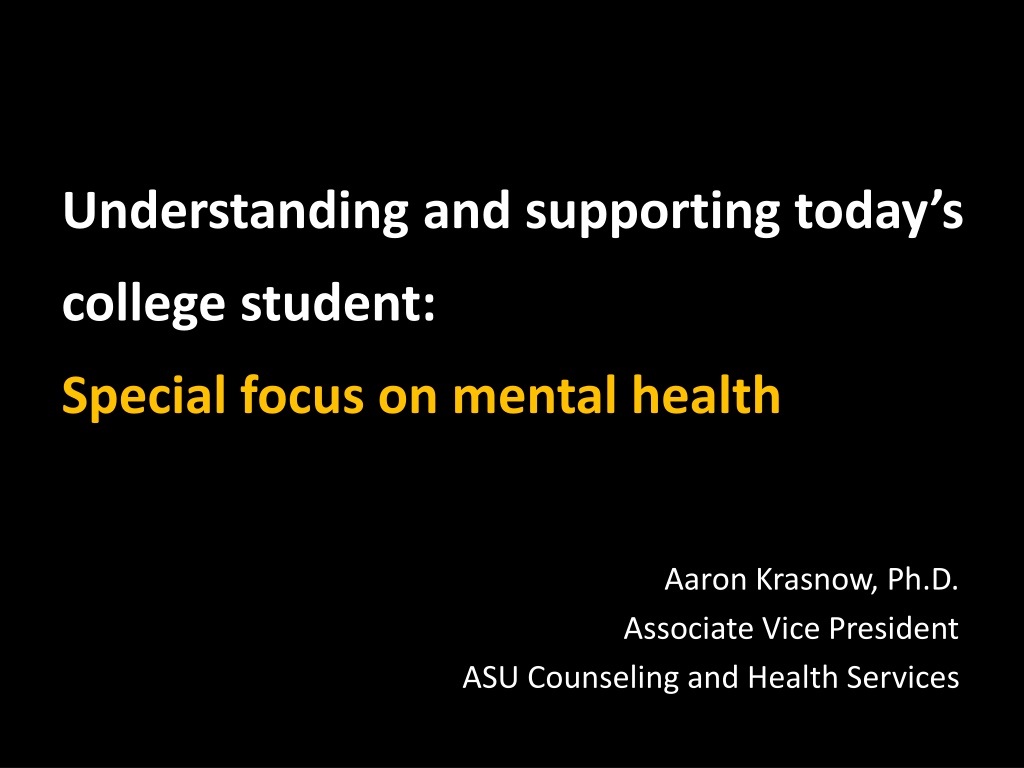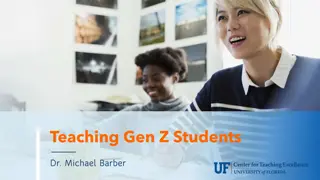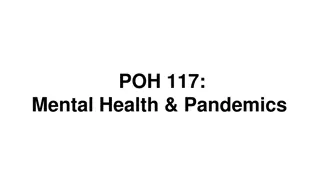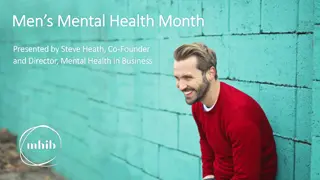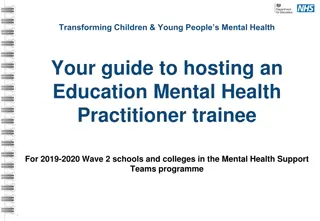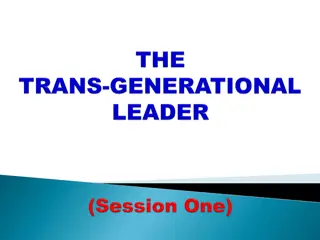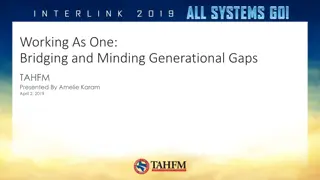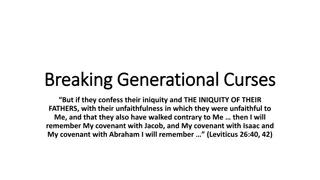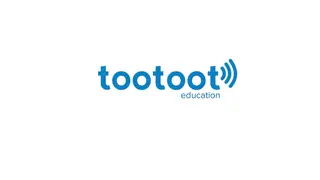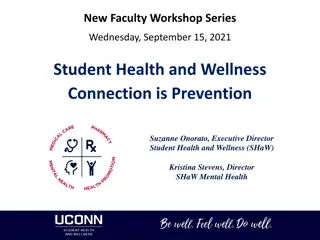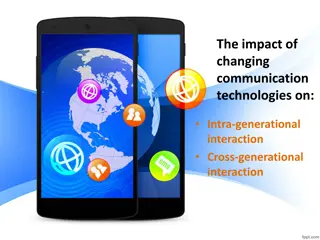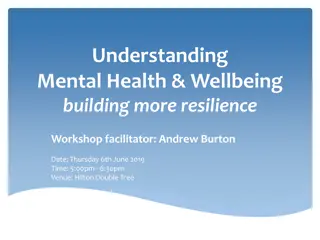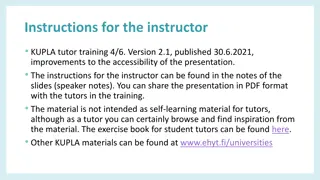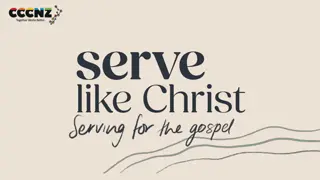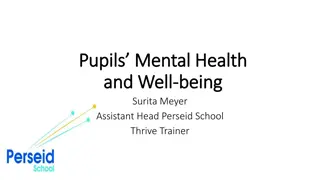Understanding and Supporting Today's College Students: Focus on Mental Health and Generational Stereotypes
Explore the challenges faced by today's college students, with a special focus on mental health issues. Dive into the topic of generational stereotypes and biases, examining perceptions and characteristics attributed to different age groups. Understand the importance of offering support and breaking down misconceptions to create a more inclusive environment on campus.
Download Presentation

Please find below an Image/Link to download the presentation.
The content on the website is provided AS IS for your information and personal use only. It may not be sold, licensed, or shared on other websites without obtaining consent from the author. Download presentation by click this link. If you encounter any issues during the download, it is possible that the publisher has removed the file from their server.
E N D
Presentation Transcript
Understanding and supporting todays college student: Special focus on mental health Aaron Krasnow, Ph.D. Associate Vice President ASU Counseling and Health Services
Lets play Guess the Generation!
Young people these days are Too close to their parents Too entitled in their opinions Feeling misunderstood Too focused on technology Poor communicators Na ve
Guess the Generation! Your choices are: GI Generation Silent Baby Boomers (1945-1963) Generation X Millennial Generation Z (1901-1924) (1925-1944) (1964-1980) (1981-2000) (2001 20xx)
Young people these days are Too close to their parents Too entitled in their opinions Feeling misunderstood Too focused on technology Poor communicators Na ve Choices: G.I., Silent, Baby Boomer, Generation X, Millennial, Generation Z
Answer G.I. Generation and Silent and Baby Boomer and Generation X and Millennial and Generation Z
Guess the generation Independent-minded Focused on community over self Cynical about the future due to chaotic domestic/global issues Idealistic Hopeful Activist See self as agent of change Choices: G.I., Silent, Baby Boomer, Generation X, Millennial, Generation Z
Answer Generation Z and Millennial and Generation X and Baby Boomer and Silent and G.I.
Talking bout my generation Independent-minded Focused on community over self Cynical about the future due to chaotic domestic/global issues Idealistic Hopeful Activist See self as agent of change
Generational stereotypes Confirmation bias Tendency to search for or interpret information in a way that confirms one s preconceptions. Vividness effect vivid or dramatic instances affect perception of a circumstance. Availability heuristic mental shortcut that relies on immediate examples when evaluating a topic. Ethnocentrism the belief that one s personal ethnic or cultural lens is better (or at least the norm).
Real strengths of todays college student Diversity and inclusivity minded Trusting of positive authority Purpose driven Hopeful Have emotion language
Real challenges Uncertainty in economy Some poorer health outcomes The double-edge of interconnectedness Stereotype threat Increasing prevalence of mental health issues
Mental Health and College Students It s real. It s related to high school and college success. It s related to the reasons students drop out. The media is paying attention.
Median age at the onset of mental health disorder Type of disorder Median age at Onset Any disorder 14 (7-24) Anxiety disorder 11 (6-21) Mood disorder 30 (18-43) Impulse-control disorder 11 (7-15) Substance-use disorder 20 (18-27) Kessler et al.
Its real Collegiate mental health is a specific and growing area of research and practice: Center for Collegiate Mental Health (CCMH) Association of University and College Counseling Center Directors (AUCCCD) American College Health Association (ACHA) National Research Consortium of Counseling Centers in Higher Education (The Research Consortium)
CCMH 2009-2015 The growth in the number of students seeking counseling was more than 5x the rate of enrollment growth. Lifetime prevalence rates for prior mental health services remain unchanged: Prior counseling (1 in 2) Prior psychiatric medication (1 in 3) Prior hospitalizations (1 in 10)
CCMH 2009-2015 Depression, Anxiety, and Social Anxiety show increasing prevalence in counseling center clients. Lifetime prevalence rate for non-suicidal self-injury (NSSI) has increased from 21.8% to 25.0% Lifetime prevalence rate for serious suicidal ideation has increased from 23.8% to 32.9% Lifetime prevalence rate for attempted suicide remains unchanged (current: 9.5%).
ACHA-NCHA II Spring 2015 National research survey Undergraduates and graduate students Random sample 108 institutions 74,438 undergraduate students surveyed
Academic Interference Factor Rate Stress 32.5% Anxiety 23.4% Sleep 22.0% Cold/Flu/Sore Throat 16.2% Depression 14.8% Work 14.7% Internet Use 12.5% Finances 7.1%
Depression and Anxiety symptoms Factor 30 days 12 months Overwhelmed 69.1% 86.7% Exhausted (not from activity) 67.1% 82.4% Sad 41.5% 65.1% Lonely 39.2% 60.5% Overwhelming anxiety 37.3% 57.7% Felt things were hopeless 28.5% 49.5% Depressed can t function 19.2% 35.3%
Suicidality Factor 30 days 12 months Seriously considered 3.6% 9.8% Intentionally harmed (NSSI) 3.0% 7.1% Attempted suicide 0.5% 1.6%
Mental health and retention Psychological adjustment predicts retention. Gerdes & Mallinckdrodt, 1994 Receiving counseling predicts retention beyond wanting but not receiving counseling. Wilson et al., 1997 Students who have received counseling retain at a higher rate. Turner & Berry, 2000 5% of students end their education due to mental health disorders Kessler et al., 1995
The media is paying attention Suicide on Campus and the Pressure of Perfection - New York Times, July 27, 2015 When Mentally Ill Students Feel Alone - The Atlantic, March 2, 2015 To Prevent Suicides in College Make Mental Health Screenings Mandatory (Opinion) - Washington Post, December 21, 2015 College of the Overwhelmed - Book, Richard Kadison, 2004
What most colleges are doing Each year between 2011 and 2015 nearly 60% of colleges reported increasing budgets for professional counselor/psychologists. Garrett Lee Smith Memorial Act SAMHSA grants. Jed Foundation Campus Programs. Training advising, faculty, staff, housing, gate-keepers. Behavioral Intervention Teams.
What the best colleges are doing Comprehensive services: Counseling and Health Services staffed by professionals Physical activity/fitness Nutrition is valued Volunteering/service culture Developmentally appropriate services: An articulated focus on college health Outsourced health models are rarely developmentally appropriate Valuing diversity: Colleges that value diversity are likely to affirm and support students who feel different than others. This predicts good outcomes in mental health.
How do these issues affect aid administrators? Increased parental involvement Traditional administrative and economic systems mismatched to current student experience. Professional-employee and student-employee factors Increased demandingness Increased crises or crises Difficulty with follow-through
Recommendations for aid teams Training in facts about emerging adults Emerging Adulthood: Jeffrey Arnett Training in human motivation Motivational interviewing Autonomy support Training in emotional intelligence skills E.I. for financial advisors and planners - Dubofsky, D., & Sussman, L. (2009). Emphasize strengths-based human-centeredness, not generational stereotypes.
Strengths-based human-centered strategies For motivation: Connect their need to their community Model positive authority Give clear statements about meaningfulness Allow and support emotionality into the conversation
Strengths-based human-centered strategies For connecting to help and resources: Model hopefulness Ask their ideas Emphasize immediacy Reinforce the connection between seeking help and their goals
How else do these issues affect you as aid administrators?
